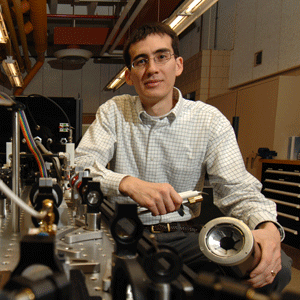 Understanding the details of non-equilibrium gas-phase chemistry in novel combustion and plasma systems is important for meeting current and future challenges in clean energy technologies.
Understanding the details of non-equilibrium gas-phase chemistry in novel combustion and plasma systems is important for meeting current and future challenges in clean energy technologies.
Terry Meyer, an assistant professor of mechanical engineering, is planning to study these details with a new laser diagnostic tool that has the potential to extract key information under reacting conditions that would otherwise be inaccessible with conventional measurement techniques.
His work will be supported by a $400,000 National Science Foundation (NSF) CAREER award for a project titled “Ultrafast Time/Frequency Domain Coherent Anti-Stokes Raman Spectroscopy for Combustion and Plasma Systems.”
Applications of this work to clean energy technologies are wide ranging, including the study of high-pressure coal and biomass gasification, catalytic upgrading of biofuels, emissions reduction during combustion of alternative fuels, and plasma synthesis of nanomaterials and silicon alloys for solar energy conversion.
To begin the study of non-equilibrium gas-phase chemistry, Meyer will develop and use a new laser diagnostic approach known as ultrafast time/frequency domain coherent anti-Stokes Raman spectroscopy. This approach will enable him to characterize temperature- and pressure-dependent energy transfer processes at more extreme conditions and at a faster rate than previous spectroscopic approaches.
“Our first step is to study the photophysics of the laser-based measurement approach and how femtosecond laser pulses interact with the gas phase,” Meyer explained. “From there, we can track the chemistry involved in various non-equilibrium processes and develop more complex models to help us predict the performance of certain technologies.”
Meyer is particularly interested in improving the efficiency of biomass conversion and combustion devices for clean and efficient use of renewable sources of energy.
“High-temperature chemically reacting processes, typical of combustion and plasma systems, are critical for converting otherwise useless materials into alternative fuels or energy conversion devices,” he said. “Understanding how this takes place is at the heart of both my research and educational objectives.”
In addition to this research, Meyer will develop outreach efforts to build interest in engineering among K-12 students as well as underrepresented and minority students. Meyer sponsors a number of undergraduate research assistants and this summer will take part in the Research Experience for Teachers program, where middle school and high school teachers will participate in projects in Meyer’s lab. His graduate students will also continue to create material for “Engineering at the Speed of Light,” a program they developed and piloted for high school students to learn through engaging exercises how light is used in engineering.
“One aspect of this work that I really enjoy is the opportunity to mentor graduate students and prepare them to be leaders in research or academia,” Meyer said. “They are learning how to get others excited about engineering while making advancements to the field of clean energy through their work in the laboratory.”